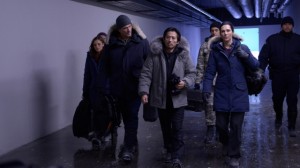Out of all of the genres that routinely cross between television and film, horror seems like one of the most under-served on the small screen, which is one of the reasons I’ve so quickly grown fond of SyFy’s original series Helix.
Obviously there are other shows on TV that tap into the horror genre, like Hannibal and American Horror Story, but their visual stylization almost puts a shiny sheen on what was once terrifying. And that isn’t meant to be a criticism; both are quite effective at storytelling and for Hannibal it’s probably the only way they can get away with showing what they do on NBC.
That’s also not to say that Helix doesn’t look visually interesting, because it certainly makes good use of its secluded stark medical / research lab setting. However, the primary difference between Helix and its counterparts is that it utilizes a blend of science fiction and classic horror tropes to build suspense and provide some scares.
Isolation Ups The Ante
[The following contains mild spoilers for the first three episode.]
As I mentioned before, one of Helix’s strongest horror elements is its isolated arctic locale. Research medical labs aren’t typically known for their warm and fuzzy vibes, so when you pair that with a remote location, the stakes just get higher. They are literally alone once the helicopter flies away in the pilot.
Of course this isn’t the only form of isolation utilized in the series. Characters become further isolated, on purpose, as a way of trying to contain the virus. And let’s be honest, in a crowded room full of panicky and possibly infected people, you are the only one looking out for yourself.
But even beyond that, the CDC team is so small that they often have to split up to accomplish the various tasks at hand – whether it be working in the lab (lookout for those infected monkeys), looking for evidence in the mostly locked-down facility (lookout for infected people), or crawling through the air duct system (lookout for your infected brother).
And all of that alone time only feeds into the paranoia and unsettling fear that something is out there, which isn’t farfetched given that someone infected with the virus is almost always on the loose. Plus Dr. Hatake and his team have been less than forthcoming with what’s really going on further lending itself to the distrust and unease that’s only grown as the unknown virus continues to spread.
But these feelings aren’t just evoked via the plot, Helix incorporates camera angles that we all know so well from horror movies. You know the ones, the shot that trails behind a character as if they are being followed and the one that positions the character just a bit more towards the edge of the frame than normal, which only means one thing – look out behind you!
The sound editing has also been quite effective. If you’re anything like me, silence can be eerie in its own right and from what I can recall most of the audio is diegetic, or at least pretty subtle, with the exception of the title card sequence that is. So the hum and beeping of machines and the hissing from the air vents is all that exists when things are going well. And none of those noises are all that calming or reassuring. This of course makes the sound of someone crawling through the air vents or banging on a door all that more jarring.
Whether the series can sustain this form of suspense is something we’ll just have to wait and see. I’ve long figured that horror doesn’t mix well with television because of its long form storytelling format. And while these horror elements initially grabbed my attention, I’d still like to see some more character development. Hopefully Helix will find a nice balance between the two in the coming weeks.
—-
Steam both seasons of Helix on TubiTV.com.
Watch and play along with the Helix Drinking Game.



